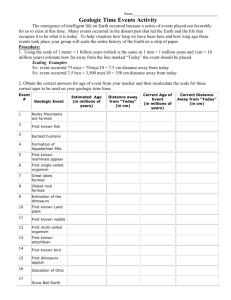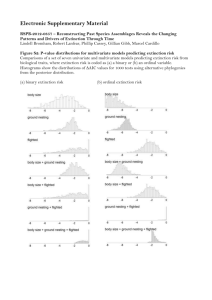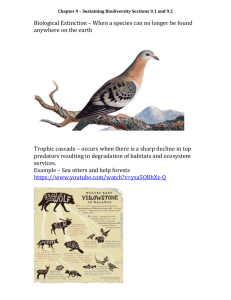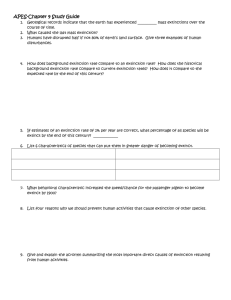Permian mass extinction
advertisement
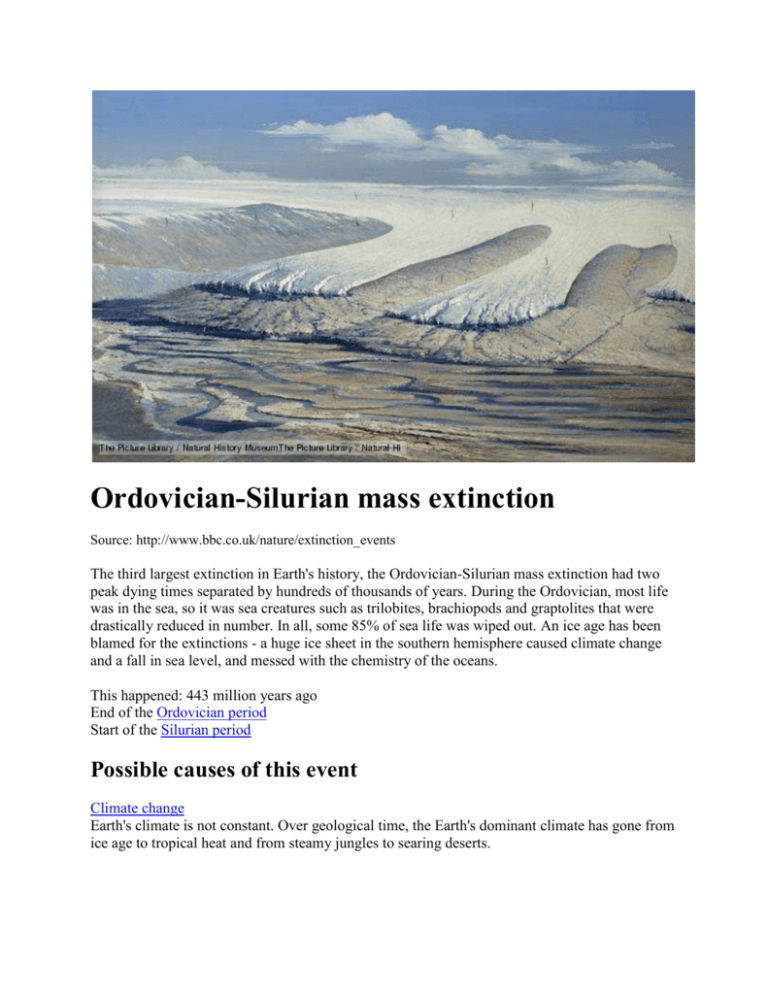
Ordovician-Silurian mass extinction Source: http://www.bbc.co.uk/nature/extinction_events The third largest extinction in Earth's history, the Ordovician-Silurian mass extinction had two peak dying times separated by hundreds of thousands of years. During the Ordovician, most life was in the sea, so it was sea creatures such as trilobites, brachiopods and graptolites that were drastically reduced in number. In all, some 85% of sea life was wiped out. An ice age has been blamed for the extinctions - a huge ice sheet in the southern hemisphere caused climate change and a fall in sea level, and messed with the chemistry of the oceans. This happened: 443 million years ago End of the Ordovician period Start of the Silurian period Possible causes of this event Climate change Earth's climate is not constant. Over geological time, the Earth's dominant climate has gone from ice age to tropical heat and from steamy jungles to searing deserts. About The Ordovician–Silurian extinction event, or quite commonly the Ordovician extinction, was the second-largest of the five major extinction events in Earth's history in terms of percentage of genera that went extinct and second largest overall in the overall loss of life. Between about 450 Ma to 440 Ma, two bursts of extinction, separated by one million years, appear to have happened. This was the second biggest extinction of marine life, ranking only below the Permian extinction. At the time, all known life was confined to the seas and oceans. More than 60% of marine invertebrates died including two-thirds of all brachiopod and bryozoan families.Brachiopods, bivalves, echinoderms, bryozoans and corals were particularly affected. The immediate cause of extinction appears to have been the movement of Gondwana into the south polar region. This led to global cooling, glaciation and consequent sea level fall. The falling sea level disrupted or eliminated habitats along the continental shelves. Evidence for the glaciation was found through deposits in the Sahara Desert. A combination of lowering of sea level and glacially-driven cooling are likely driving agents for the Ordovician mass extinction. Late Devonian mass extinction Source: http://www.bbc.co.uk/nature/extinction_events Three quarters of all species on Earth died out in the Late Devonian mass extinction, though it may have been a series of extinctions over several million years, rather than a single event. Life in the shallow seas were the worst affected, and reefs took a hammering, not returning to their former glory until new types of coral evolved over 100 million years later. In fact, much of the sea bed became devoid of oxygen, rendering it effectively out of bounds for anything except bacteria. Changes in sea level, asteroid impacts, climate change and new kinds of plants messing with the soil have all been blamed for these extinctions. This happened: 359 million years ago End of the Devonian period Start of the Carboniferous period Possible causes of this event Impact events Impact events, proposed as causes of mass extinction, are when the planet is struck by a comet or meteor large enough to create a huge shockwave felt around the globe. Widespread dust and debris rain down, disrupting the climate and causing extinction on a global, rather than local, scale. About The Late Devonian extinction was one of five major extinction events in the history of the Earth's biota. A major extinction, the Kellwasser Event, occurred at the boundary that marks the beginning of the last phase of the Devonian period, the Famennian faunal stage, (the FrasnianFamennian boundary), about 374 million years ago. Overall, 19% of all families and 50% of all genera went extinct. A second, distinct mass extinction, the Hangenberg Event, closed the Devonian period Although it is clear that there was a massive loss of biodiversity in the Later Devonian, the extent of time during which these events took place is uncertain, with estimates ranging from 500,000 to 25 million years, extending from the mid-Givetian to the end-Famennian. Nor is it clear whether it concerned two sharp mass extinctions or a series of smaller extinctions, though the latest research suggests multiple causes and a series of distinct extinction pulses through an interval of some three million years. Some consider the extinction to be as many as seven distinct events, spread over about 25 million years, with notable extinctions at the ends of the Givetian, Frasnian, and Famennian stages. By the late Devonian, the land had been colonized by plants and insects. In the oceans, there were massive reefs built by corals and stromatoporoids on land. Euramerica and Gondwana were beginning to converge into what would become Pangea. The extinction seems to have only affected marine life. Hard-hit groups include brachiopods, trilobites, and reef-building organisms; the latter almost completely disappeared, with coral reefs only returning upon the evolution of modern corals during the Mesozoic. The causes of these extinctions are unclear. Leading theories include changes in sea level and ocean anoxia, possibly triggered by global cooling or oceanic volcanism. The impact of a comet or another extraterrestrial body has also been suggested. Some statistical analysis suggests that the decrease in diversity was caused more by a decrease in speciation than by an increase in extinctions. This might have been caused by invasions of cosmopolitan species, rather than any single event. Surprisingly, jawed vertebrates seem to have been unaffected by the loss of reefs or other aspects of the Kellwasser event, while Permian mass extinction Source: http://www.bbc.co.uk/nature/extinction_events The Permian mass extinction has been nicknamed The Great Dying, since a staggering 96% of species died out. All life on Earth today is descended from the 4% of species that survived. The event turns out to have been complex, as there were at least two separate phases of extinction spread over millions of years. Marine creatures were particularly badly affected and insects suffered the only mass extinction of their history. Many causes have been proposed for the event: asteroid impact, flood basalt eruptions, catastrophic methane release, a drop in oxygen levels, sea level fluctuations or some combination of these. This happened: 248 million years ago End of the Permian period Start of the Triassic period Possible causes of this event Catastrophic methane release Flood basalt eruptions Climate change Impact events What was killed by this event Merostomata Sea scorpions Trilobites Trilobites About The Permian–Triassic (P–Tr) extinction event, informally known as the Great Dying, was an extinction event that occurred 252.28 Ma (million years) ago, forming the boundary between the Permian and Triassic geologic periods, as well as the Paleozoic and Mesozoic eras. It was the Earth's most severe extinction event, with up to 96% of all marine species and 70% of terrestrial vertebrate species becoming extinct. It is the only known mass extinction of insects. Some 57% of all families and 83% of all genera became extinct. Because so much biodiversity was lost, the recovery of life on Earth took significantly longer than after any other extinction event. This event has been described as the "mother of all mass extinctions." Researchers have variously suggested that there were from one to three distinct pulses, or phases, of extinction. There are several proposed mechanisms for the extinctions; the earlier phase was likely due to gradual environmental change, while the latter phase has been argued to be due to a catastrophic event. Suggested mechanisms for the latter include large or multiple bolide impact events, increased volcanism, coal/gas fires and explosions from the Siberian Traps, and sudden release of methane clathrate from the sea floor; gradual changes include sea-level change, anoxia, increasing aridity, and a shift in ocean circulation driven by climate change. Triassic-Jurassic mass extinction Source: http://www.bbc.co.uk/nature/extinction_events During the final 18 million years of the Triassic period, there were two or three phases of extinction whose combined effects created the Triassic-Jurassic mass extinction event. Climate change, flood basalt eruptions and an asteroid impact have all been blamed for this loss of life. Many types of animal died out, including lots of marine reptiles, some large amphibians, many reef-building creatures and large numbers of cephalopod molluscs. Roughly half of all the species alive at the time became extinct. Strangely, plants were not so badly affected. This happened: 200 million years ago End of the Triassic period Start of the Jurassic period Possible causes of this event Flood basalt eruptions Climate change Impact events What was killed by this event Reptiles Postosuchus Synapsids Placerias About The Triassic–Jurassic extinction event marks the boundary between the Triassic and Jurassic periods, 199.6 million years ago, and is one of the major extinction events of the Phanerozoic eon, profoundly affecting life on land and in the oceans. In the seas a whole class (conodonts) and twenty percent of all marine families disappeared. On land, all large crurotarsans (nondinosaurian archosaurs) other than crocodilians, some remaining therapsids, and many of the large amphibians were wiped out. At least half of the species now known to have been living on Earth at that time went extinct. This event vacated terrestrial ecological niches, allowing the dinosaurs to assume the dominant roles in the Jurassic period. This event happened in less than 10,000 years and occurred just before Pangaea started to break apart. In the area of Tübingen (Germany), a Triassic-Jurassic bonebed can be found, which is characteristic for this boundary. Statistical analysis of marine losses at this time suggests that the decrease in diversity was caused more by a decrease in speciation than by an increase in extinctions. Several explanations for this event have been suggested, but all have unanswered challenges: Gradual climate change or sea-level fluctuations during the late Triassic. However, this does not explain the suddenness of the extinctions in the marine realm. Asteroid impact, but so far no impact crater of sufficient size has been dated to coincide with the Triassic–Jurassic boundary. The eroded Rochechouart crater in France has most recently been dated to 201 ±2 million years ago, but at 25 km across (possibly up to 50 km across originally), appears to be too small. (The impact responsible for the annular Manicouagan Reservoir occurred about 12 million years before the extinction event.) Massive volcanic eruptions, specifically the flood basalts of the Central Atlantic Magmatic Province (CAMP), would release carbon dioxide or sulfur dioxide and aerosols, which would cause either intense global warming (from the former) or cooling (from the latter). The isotopic composition of fossil soils of end Triassic and Early Jurassic has been tied to a large negative carbon isotope excursion (Whiteside et al. 2010). Carbon isotopes of lipids (n-alkanes) derived from leaf wax and lignin, and total organic carbon from two sections of lake sediments interbedded with the CAMP in eastern North America have shown carbon isotope excursions similar to those found in the mostly marine St. Audrie’s Bay section in England; the correlation suggests that the end-Triassic extinction event began at the same time in marine and terrestrial environments, slightly before the oldest basalts in eastern North America but simultaneous with the eruption of the oldest flows in Morocco (Also suggested by Deenen et al., 2010), with both a critical CO2 greenhouse and a marine biocalcification crisis. Contemporaneous CAMP eruptions, mass extinction, and the carbon isotopic excursions are shown in the same places, making the case for a volcanic cause of a mass extinction. The catastrophic dissociation of gas hydrates (suggested as one possible cause of the largest mass extinction of all time, the so-called "Great Dying" at the end of the Permian Period) may have exacerbated greenhouse conditions. Cretaceous-Tertiary mass extinction Source: http://www.bbc.co.uk/nature/extinction_events The Cretaceous-Tertiary mass extinction - also known as the K/T extinction - is famed for the death of the dinosaurs. However, many other organisms perished at the end of the Cretaceous including the ammonites, many flowering plants and the last of the pterosaurs. Some groups had been in decline for several million years before the final event that destroyed them all. It's suggested that the decline was due to flood basalt eruptions affecting the world's climate, combined with drastic falls in sea level. Then a huge asteroid or comet struck the seabed near the Yucatan Peninsula in Mexico and was the straw that broke the camel's back. This happened: 65 million years ago End of the Cretaceous period Start of the Palaeocene epoch Possible causes of this event Flood basalt eruptions Impact events What was killed by this event Reptiles Ankylosaurs Armoured dinosaurs Bird-hipped dinosaurs Ceropod dinosaurs Duck-billed dinosaurs Horned dinosaurs Triceratops Dromaeosaurs Lizard-hipped dinosaurs Nothronychus Sauropod dinosaurs Sauropodomorph dinosaurs Therizinosaurus Theropod dinosaurs Tyrannosaurs Tyrannosaurus rex Plesiosauria Plesiosaurs Pliosaurs Hatzegopteryx Pterosaurs Dinosaurs Cephalopods Ammonites What the Earth was like Global palaeogeographic reconstruction of the Earth at the time of the Cretaceous-Tertiary mass extinction. Credit: Dr Ron Blakey, NAU Geology. Death of a dynasty - the end of the Cretaceaous At the end of the Cretaceous Period, 65 million years ago, all the dinosaurs died out. Why this happened is one of the most frequently asked - and intriguing - questions in palaeontology. There have been many different ideas put forward to explain why the dinosuars died out. The two most likely are that their habitat slowly changed, and that a meteor impact triggered their extinction. Gradualist theory The gradualist hypothesis points to declines in the numbers and diversity of different groups of land and marine animals. It suggests that the extinction of these groups was due to climate change. The climate at the end of the Cretaceous was cooling - and a fall in sea level reduced dinosaur and shallow water marine animal habitats. Impact theory The impact hypothesis gets a lot of press coverage because it is spectacular. There is good geophysical evidence for the occurrence of an asteroid impact at the end of the Cretaceous. A band of clay rich in the mineral iridium was deposited at the end of the Cretaceous and has been found at many places in the world. This mineral is rare on Earth but more common in meteorites. It has been suggested that the impact would have triggered a nuclear winter scenario that would have caused the death of the dinosaurs as well as the pterosaurs, several families of birds and mammals and also marine animals such as the plesiosaurs and ammonites. Volcano At the end of the Cretaceous there were a lot of volcanic eruptions, at least in some parts of the world. The Deccan Traps, huge flood basalts, were deposited at this time, and the dust and gases erupted at the same time would have had caused environmental changes over a wide area. Will we ever know? Unfortunately, while these hypotheses are plausible and they can both explain how many animals went extinct, neither can explain why certain animals died out while others survived. Why did the dinosaurs, which were so successful, die out, while other animals such as frogs, which we know are environmentally sensitive, survive? Although it is usually assumed that the dinosaurs all went extinct all at the same time all over the world, the truth of the matter is that we only have high resolution data for North America. In other parts of the world there is either no terrestrial record or we do not have good enough age resolution. It is likely that as China and other countries outside of Europe and the US are studied more intensively we will be able to gather more data and build up a more comprehensive picture of what was going on in the world at the end of the Cretaceous period.
